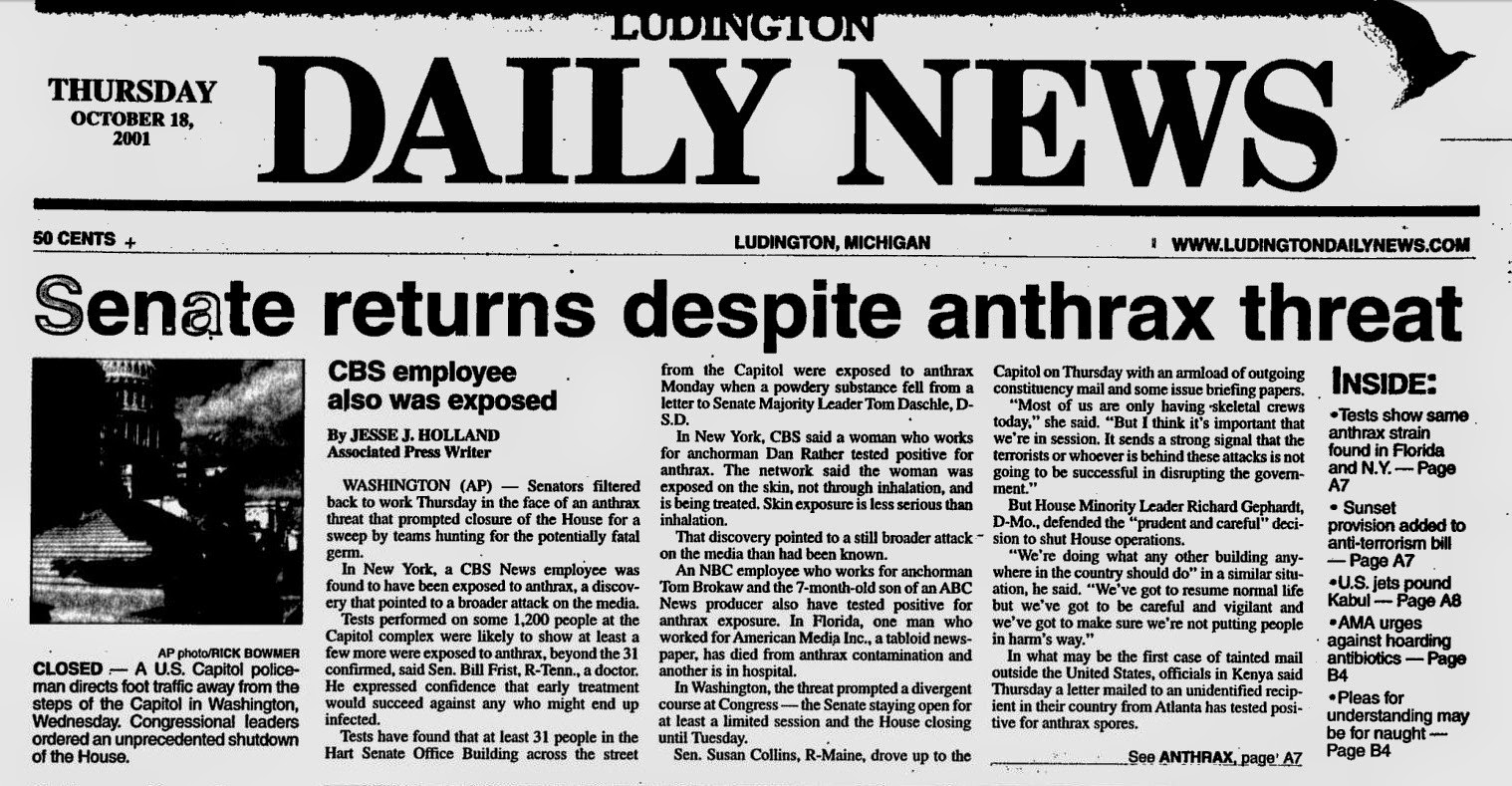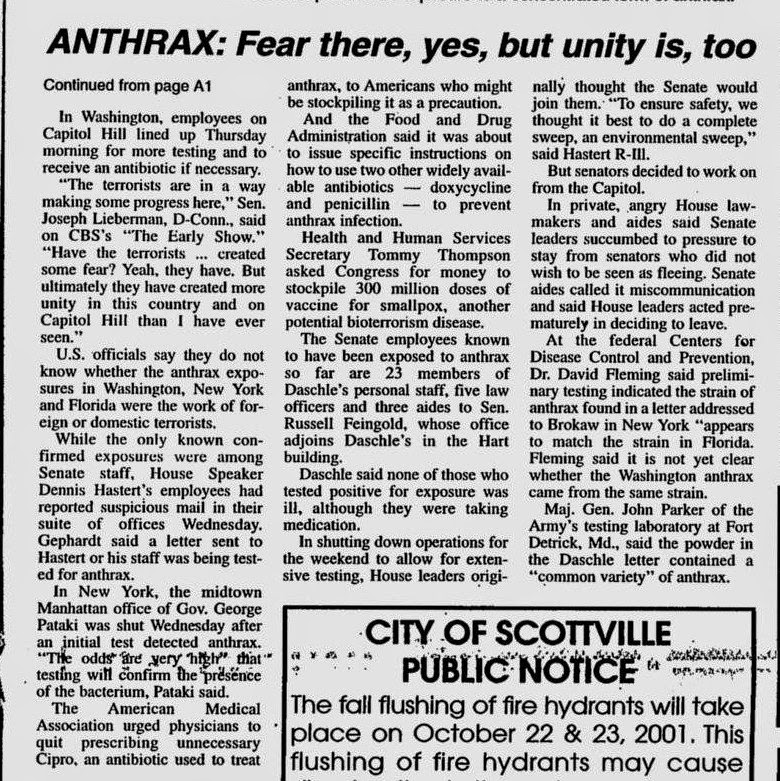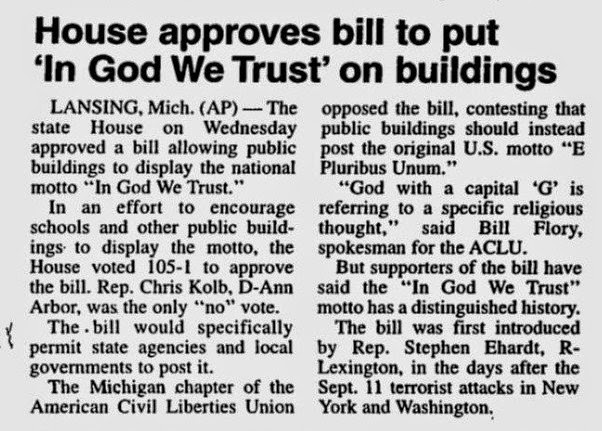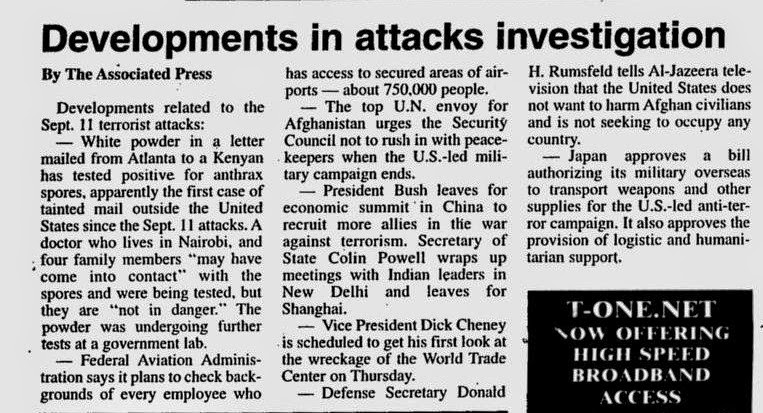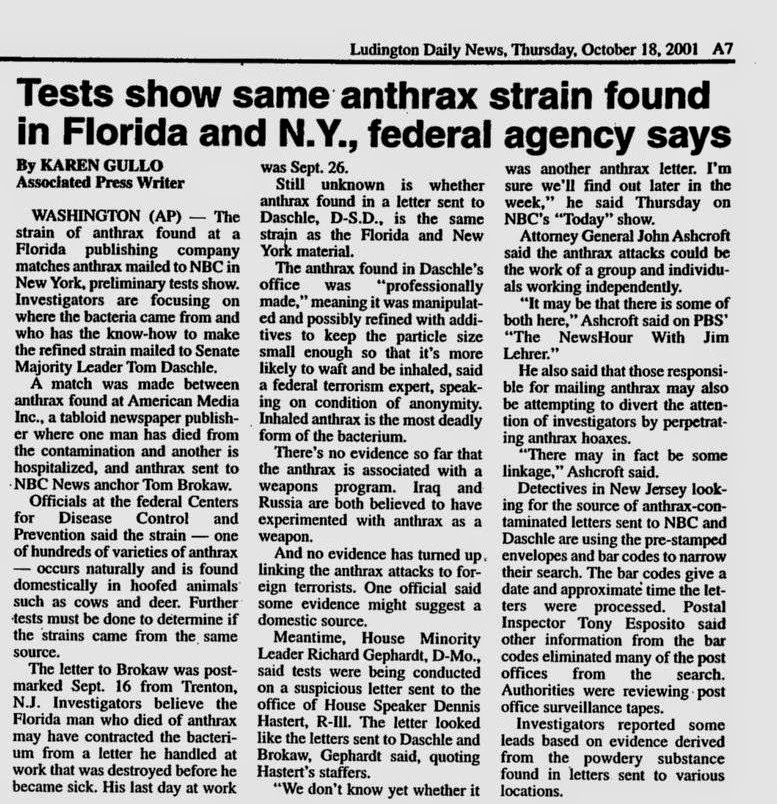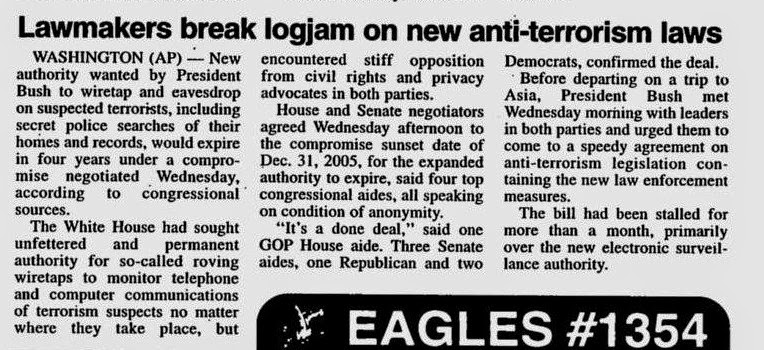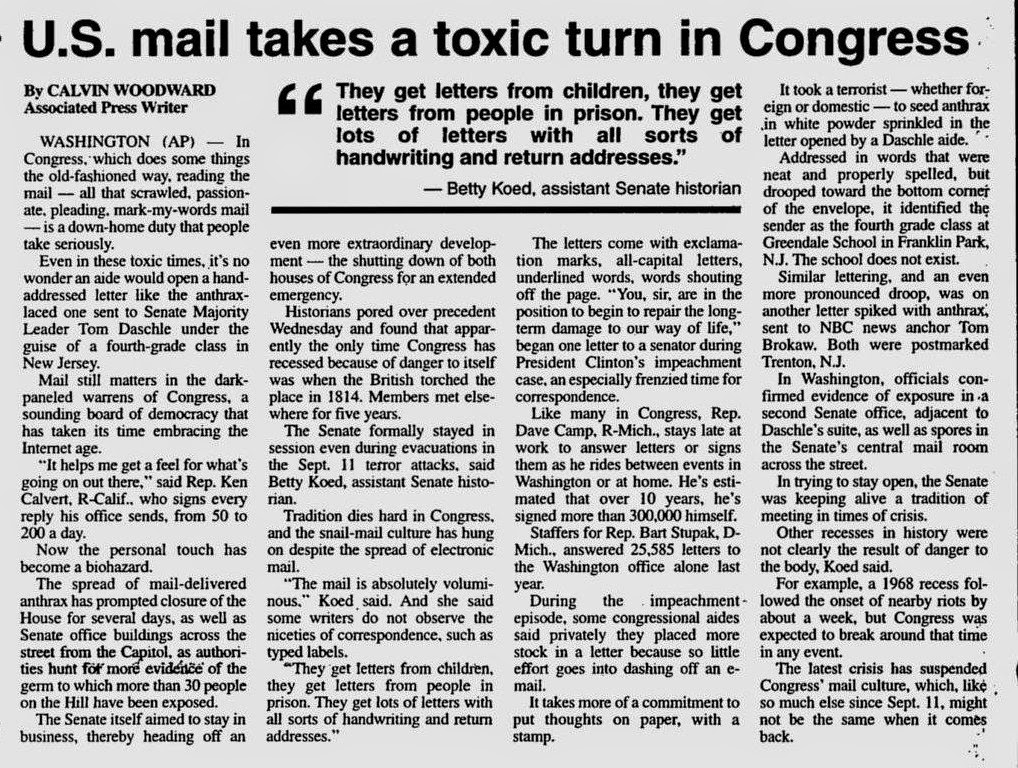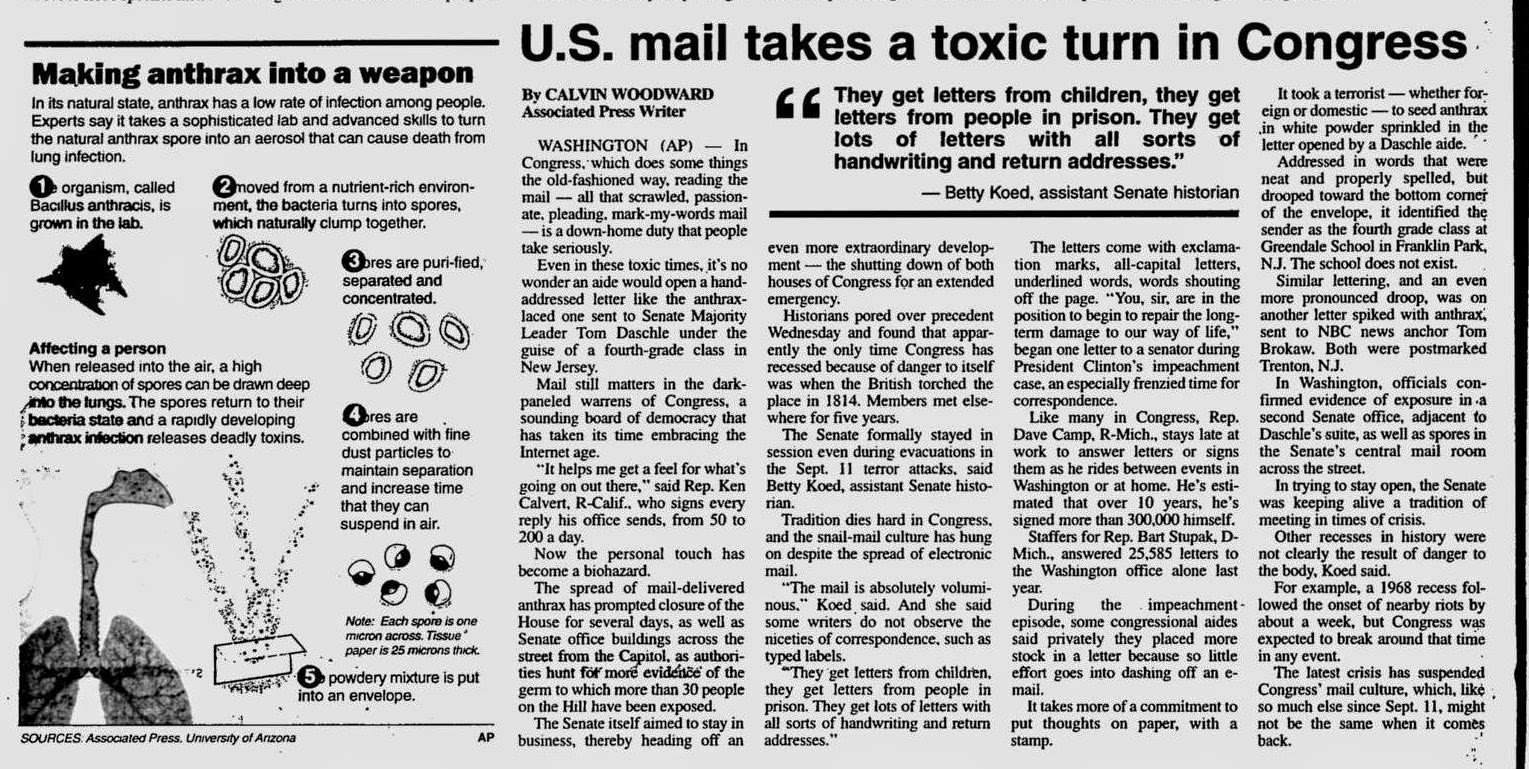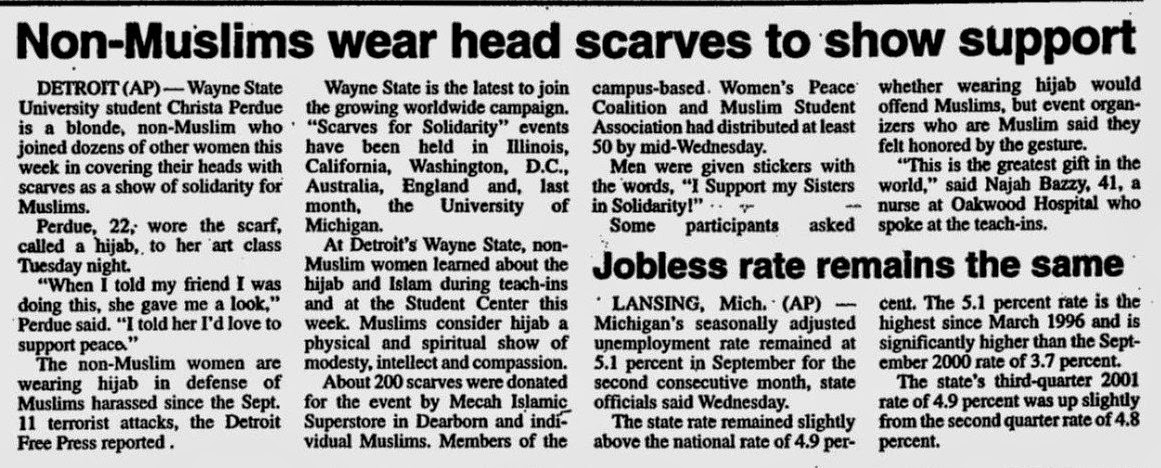_______________________________________________________________________________
August 24, 2002, Washington Post,
U.S. Report Faulted Anthrax Prober; FBI Official in Charge of Case Avoided Discipline Over Ruby Ridge Study, by Dan Eggen,
The official in charge of the FBI's anthrax probe was accused of misconduct and recommended for discipline for his role in a flawed review of the deadly Ruby Ridge standoff, but a Justice Department official later concluded that punishment was unwarranted, according to newly revealed information about the case.
Van A. Harp, a 32-year FBI veteran who now heads the bureau's Washington field office, allegedly
"committed misconduct" by helping to prepare an incomplete report on the 1992 Ruby Ridge siege that had the effect of protecting high-level FBI officials, according to
a confidential 1999 report by the
Justice Department's Office of Professional Responsibility.
The report by
Justice Department attorney Richard M. Rogers recommended a letter of censure or suspension for Harp, but
Stephen R. Colgate, then the assistant attorney general, rejected that recommendation
in January 2001, sources said. As has been disclosed,
Colgate also declined to issue penalties against others, including
then-FBI Director Louis J. Freeh. Harp's role in the investigations of Ruby Ridge had not been previously reported.
Harp was put in charge of the Washington field office in July 2001, an influential position that thrust him into the spotlight when the office took the lead in the probe of last fall's deadly anthrax mailings. He previously was head of the FBI office in Cleveland. He worked in the Buffalo office at the time of the Ruby Ridge probe.
In a written statement, Harp said that leaks about his role in the Ruby Ridge inquiries violate
"all sense of propriety" and ignore reviews that exonerated him.
"Actions such as this impugn not only my integrity but also the judgment of FBI and DOJ [Department of Justice]
officials in the decision-making progress," Harp wrote.
"My actions have been scrutinized at the highest levels of the FBI and DOJ, and no wrongdoing was found. . . . I firmly stand on my record."
FBI spokesman Mike Kortan said it is clear that Harp and others were exonerated.
"The decision on any proposed discipline was ultimately made by senior Justice officials, who in this case determined no wrongdoing on the part of these individuals," Kortan said.
But in a letter Thursday to
FBI Director Robert S. Mueller III, the
National Whistleblower Center alleged that the lack of punishment for Harp and others underscores a "perverse culture" at the FBI in which senior managers protect each other from fair scrutiny.
"The wrongdoers keep rising to the top," said the letter from
Kris Kolesnik, the center's director, and
Frederic Whitehurst, a former FBI chemist who revealed problems at the bureau's crime lab.
"Meanwhile, those who refuse to look the other way face a dead-end in their careers."
Kolesnik and Whitehurst urged
Mueller, who was named to head the FBI eight months after the Ruby Ridge sanction decisions were made, to release internal documents about Ruby Ridge and its aftermath. They contended that disclosure would
"help restore the public's confidence that was eroded because of misconduct in these investigations."
Rank-and-file FBI agents have long complained that senior officials cover for each other during controversies, while lower-level agents shoulder the blame.
In the Ruby Ridge case, the Justice Department's inspector general's office opened a probe last year into allegations that senior FBI officials retaliated against agents who uncovered flaws in the bureau's handling of the siege. That probe is not expected to be completed before fall, sources said.
The standoff in Ruby Ridge, Idaho, began with a shootout on Aug. 21, 1992, that resulted in the deaths of
U.S. Marshal William Degan and
Sammy Weaver, the young son of
white separatist Randy Weaver. The next day, an FBI sniper killed Weaver's wife, Vicki, as the result of unprecedented "shoot-to-kill" orders that were later ruled illegal by a federal court.
Most of the
FBI supervisors who conducted a series of flawed inquiries into the case faced no disciplinary action and were promoted to senior jobs throughout the bureau, according to watchdog groups and others familiar with the case.
A case in point, according to the whistleblower group, is the 1993 investigative team that included Harp and was led by
FBI Inspector Robert E. Walsh.
Seven senior members of the team were later promoted despite serious questions about their inquiry,
Kolesnik's group charged in the letter to
Mueller.
A Senate subcommittee investigation found that Walsh's report, issued in 1994, was tilted to justify the shooting of
Vicki Weaver. Later investigations found that the shoot-to-kill orders were issued by
then-Assistant Director Larry Potts, and that
the official who supervised the case from FBI headquarters,
Danny Coulson, knew about the orders.
A follow-up inquiry by Rogers alleged that Walsh and Harp failed to ensure that their inquiry was complete, and were
"motivated by a desire to counterbalance the perceived bias" against the FBI and
"thereby protect some subjects of the investigation," the report read, according to sources with access to the findings.
"The Walsh report was drafted in a way that tended to direct attention away from Potts and Coulson," said the Rogers report, which was completed in June 1999.
The report recommended discipline for Harp, but not for Walsh, who had retired, sources said. The Rogers report also condemned a review conducted by
Charles Mathews III, now head of the FBI's office in Portland, Ore., and recommended discipline for him. Investigators said
Mathews should have recused himself because he was a friend of
Coulson; Mathews could not be reached for comment.
Walsh, reached in Chicago, where he now runs an investigative consulting business, said the Rogers report's criticisms of him and others, including Harp and Mathews, were unfounded. He and Harp were
limited in what they could investigate and were not allowed to interview federal marshals or prosecutors, Walsh said.
Walsh, who was a friend of
Potts, also denied allegations that the report was "skewed" to protect
senior FBI officials.
_______________________________________________________________________________
November 16, 2002, Washington Post,
FBI Plays Favorites in Discipline, Report Says; Justice IG Says Senior Managers' Miscues Overlooked, by Dan Eggen,
August 1, 2001, OKC Submariner Personal Research,
FBI Director Nominee Mueller Helped FBI and DOJ Cover Up Evidence on Waco, Ruby Ridge, OKC Bombing, by Patrick B. Briley,
This article presents, analyzes and adds important new information about a recent letter to the editor of the Washington Times concerning the nominee for FBI Director, Robert Mueller. The letter was published on page A-11 of the Times on July 28, 2001 and was written by Patrick Downes of Boston. His letter was entitled "FBI Appointment Needs More Investigation". While Downes letter is to the editor, it provides valuable information about Mueller's previous role in DOJ collusion to help facilitate FBI and DOJ corruption in mishandling evidence in important cases.
The text of the letter is first reproduced and then my new information and analysis follows after the letter text. Downes’ letter and my information and analysis provide important insights into the story behind Mueller’s and Attorney General Ashcroft’s handling of the corruption at DOJ and FBI concerning Waco, Ruby Ridge and the OKC bombing.
TEXT OF DOWNES’ LETTER:
July 28, 2001, The Washington Times, Letters, FBI Appointment Needs More Investigation, by Patrick Downes, Boston,
President Bush's nomination of Robert S. Mueller III to become the director of the FBI should have raised a few more eyebrows than it did.
Mr. Mueller's record as a prosecutor should bring into question his ability and willingness to correct some of the long-standing problems facing the FBI. In particular, Mr. Mueller’s record as a prosecutor is not that of someone who has demanded that government be more open and accountable and that it practice fair disclosure of evidence weighed against defendants.
While serving in the northern district of California, Mr. Mueller instituted a policy known as a "Brady waiver" that institutes and protects the federal government from a defendant’s due-process guarantee as afforded by the U.S. Constitution.
The waiver requires defendants who plead guilty to a crime to forgo a defendant’s constitutional right to present evidence of their evidence at a later date. Furthermore, the waiver would be enforceable even if it were established that the government withheld evidence in its possession before, during or after a trial that indicated a defendant is innocent of the charges brought against him or her.
At WACO, RUBY RIDGE and most recently during the trial of OKLAHOMA CITY BOMBER, Timothy McVeigh, the FBI failed to properly disclose all of the evidence in a timely and credible manner. The FBI’s credibility as it relates to the fair and proper disclosure of evidence against criminal defendants is in ruins.
Given that Mr. Mueller instituted a policy that effectively shields the government from accepting responsibility for withholding and concealing evidence, its questionable whether he is the right person to become director at this critical juncture in the FBI’s history.
MY ADDITIONAL INFORMATION AND ANALYSIS
Even while US Attorney in San Francisco, Mueller worked to cover-up the OKC bombing, Waco and Ruby Ridge evidence by changing the rules of evidence so that the FBI and prosecution did not have to share as much evidence with defense attorneys in the cases as would have been required in the past. He changed the Brady rules of evidence in concert with the US prosecutor Beth Wilkinson in the McVeigh and Nichols case who had assumed a position in the same department at DOJ that Mueller had worked earlier.
Mueller was brought into DC to head the transition team for Ashcroft and Mueller proceeded to steer Ashcroft through the cover-ups by FBI and DOJ on the OKC bombing case. Mueller did such a superb job that Ashcroft personally nominated Mueller to Bush for FBI director to help perpetuate the FBI and DOJ cover-ups of Waco, Ruby Ridge and the OKC bombing.
For some of the details of the FBI and DOJ cover-up of the OKC bombing please read my article Ashcroft Relies On Evidence Obstructed by the FBI and US Prosecutors In OKC Bombing Case which was posted on the FreeRepublic.com on May 29, 2001.
The FBI and DOJ colluded to lie before the court during the trials, to falsify FBI 302 reports, to withhold 302 reports, to falsely rewrite 302 reports, to deliberately not write 302 reports, to doctor and withhold key surveillance tape evidence, and to threaten key John Doe and foreknowledge witnesses including law enforcement and military personnel in OKC.
Mueller was also involved in covering up the Noriega, BCCI and BNL scandals of Bush Senior. Mueller worked with Wilkinson on the Noriega case. Mueller also worked closely at several points with Larry Potts, the former Deputy Director of the FBI, who was kicked out of the FBI for lying about the FBI having Vickie Weaver murdered.
The head of the OKC FBI office, Marquise worked directly with Mueller on the Pan Am 103 bombing and Marquise is to be given the AG Distinguished service award by Ashcroft. Marquise verbally attacked four FBI agents who were on 60 minutes II last month describing the FBI cover-up in the OKC bombing.
If Ashcroft continues to allow himself to be led around by the nose by FBI and DOJ holdovers from the previous administration, such as Robert Mueller, then Ashcroft himself will be rendered useless and will himself become part of the corruption problem plaguing the DOJ and FBI.
It has been six weeks since Ashcroft was hand delivered a letter written by OKC bombing witness Gloria Smith describing three John Does in the case that the FBI deliberately covered-up. Ashcroft has failed to take action to have these John Does adequately investigated, apprehended or questioned and he has not had anyone contact Gloria Smith.
The story of the John Does and Gloria Smith’s letter to Ashcroft was reported in my article OKC Bombing Witness Requests Ashcroft Action On Three John Does which was posted on the FreeRepublic.com on June 14, 2001.
If Ashcroft is relying on DOJ personnel such as Sean Connelly or Beth Wilkinson and especially FBI Director designee Robert Mueller and others involved in the FBI cover-up, then it is doubtful that Ashcroft, the FBI or the DOJ will do anything adequate about Gloria Smith’s John Does or will really investigate the FBI and DOJ cover-ups in the OKC bombing.
Senators Hatch and Leahy have gushed over Mueller in confirmation hearings and recently said that Congress will not need to continue close oversight of the FBI once Mueller is in charge for a while. This is an absolute abdication of the Senate’s role to continue indefinitely overseeing the FBI and is a blank check that should never be given to the FBI and particularly to “Mr. evidence cover-up artist” Robert Mueller.
Even former FBI agent Gary Aldrich who wrote “Unlimited Access” just advocated in his newsletter (from the Patrick Henry Center) giving Robert Mueller "a blank check" (these are Aldrich's exact words) to run and cleanup the FBI. Aldrich is like the Senators who really do not want to oversee the FBI, they just want to create the allusion that the FBI can run itself without oversight once a few cosmetic changes are made. They like Mueller so far are still perpetuating the FBI status quo of corrupt policies that endanger the American people and threaten their freedoms and lives.
________________________________________________________________________________
May 29, 2001, FreeRepublic.com, Ashcroft Relies On Evidence Obstructed by the FBI and US Prosecutors In OKC Bombing Case
June 14, 2001, FreeRepublic.com, OKC Bombing Witness Requests Ashcroft Action On Three John Does,
Speaking of Mueller......Did you know that Boxer backed his nomination to head the FBI?
Did you know that the Judiciary Commitee and the Senate acted on his nomination and confirmation faster than most and within 2 weeks he was confirmed?
Did you knowit took over a month to swear him in as FBI director?
Did you know he was Acting Deputy Director of the DOJ from January through May, went home for a month and was then nominated to head the FBI?
Liberal Senators Back Mueller for FBI; Privacy Advocates Wary
Wes Vernon Friday, July 6, 2001
WASHINGTON - Sen. Barbara Boxer, D-Calif., a rival to Sen. Edward Kennedy as the Senate's most reliable leftist, has given a fulsome endorsement to Robert Mueller, President Bush's pick for FBI director. Privacy advocates are withholding judgment.
In a statement faxed by her office to NewsMax.com, Boxer praises Mueller, U.S. attorney for Northern California, as having "all the qualities needed to become an outstanding Director of the FBI." "He has extensive law enforcement experience at every level, from line prosecutor to U.S. Attorney to high level positions in the Justice Department," she added.
"His courage and devotion to his country are unquestioned and were demonstrated early in his career when he become a highly decorated Marine officer."
Speaking of Kennedy, his reaction was to recall that Mueller had "demonstrated considerable skill in the U.S. Attorney's office in Boston and San Francisco, and as head of the Criminal Division in the Department of Justice." Boxer's enthusiasm contrasts with a more "wait and see" approach by privacy advocates.
Noting that Mueller was familiar with technical issues involving the FBI, Lisa Dean, vice president of technology policy for the Free Congress Foundation, expressed the hope that the nominee would have a sense of "balance" between high-technology methods of catching criminals and the privacy rights of Americans.
"I don't know how he comes down on" that "balance," said David Sobel, general counsel of the Electronic Privacy Information Center. He said he had met the nominee in a meeting hosted by Attorney General John Ashcroft. That meeting with law enforcement officials and privacy advocates was to discuss computer crime and related privacy concerns.
Sobel said he did not know Mueller's views on those matters, but "he is certainly knowledgeable about them." Accuracy in Media President Reed Irvine, who has frequently clashed with the FBI over investigations which he believes were either botched or covered up, referred NewsMax.com to a June 11 column by New York Times columnist William Safire.
Recalling that Mueller led the Justice Department's Criminal Division in the senior Bush's administration, the columnist describes him as an "intelligent apparatchik." Apparently, the FBI pick is a survivor of the bureaucratic wars who has managed to avoid rocking boats in the administrations of both Bushes and Clinton. The following are examples:
1 - Mueller "showed a marked lack of interest in the Iraqgate investigation." The accusation in that case was that the Bush administration, having received near-universal acclaim for victory over Iraq in the Gulf War, had stumbled into that conflict in the first place through diplomatic blunders that emboldened Saddam Hussein.
2 - "As Democrat [Eric] Holder moved up the ladder at [Clinton-Reno] Justice, so too did his friend Mueller, and — with strong support from Senator Barbara Boxer - was rewarded with a Clinton appointment as U.S. Attorney in San Francisco."
3 - When Bush the younger arrived, Mueller "spun about and made his bureaucratic expertise known to the knocked about [Attorney General] John Ashcroft." He saw that his old associates in the public integrity section remained secure.
Republican lawmakers are reluctant to publicly criticize their president. But GOP staffers who are up to speed on the thinking inside FBI and Justice Department circles will express their concerns off the record.
'Too Clever'
"This guy's just a little too clever by half," said one, "How can we trust somebody who walks both sides of the street? Didn't we have enough of that with [recently departed FBI Director Louis] Freeh?"
While former FBI directors William Sessions and William Webster were often criticized for naiveté on bureaucratic intrigue, Mueller, as some Washingtonians see it, may have the kind of bureaucratic smarts that are good for him, but not necessarily for the country. On the other hand, another Republican staffer said there was reason to believe that Mueller will be an improvement over Freeh, about whom this source had no enthusiasm.
"You have to remember," he said, "he has the backing of both the president and John Ashcroft. And they're both good guys. If he wants to please them, he'll do the right thing [on privacy]."
Although some may regard that kind of comment as a form of "whistling past the graveyard," rare is the Republican on the Hill ready to go to war over this nomination, at least at this early stage. Senate Judiciary Chairman Patrick Leahy, D-Vt., issued a noncommittal statement noting his panel's planned "oversight hearings" on the FBI, and adding it "will be the committee's job to determine if Mr. Mueller is the right person for the job." The committee's ranking Republican and former chairman, Sen. Orrin G. Hatch, R-Utah, lauded Bush for his "excellent choice" in picking Mueller.
"I am confident that Mr. Mueller's distinguished history of public service and as a federal prosecutor" will provide "dynamic leadership," the Utah Republican declared.
California's other liberal Democrat senator, Dianne Feinstein, praised the selection of Mueller, Fox News Channel reported Thursday evening.
_______________
Congressional Record: August 2, 2001 (Senate) Page S8680-S8691 robert s. mueller, iii, to be director of the federal bureau of investigation
Mr. LEAHY. Madam President, I have moved swiftly in the Judiciary Committee to consider and move forward the nomination of Robert S. Mueller, III, to be Director of the Federal Bureau of Investigation.
His nomination was sent to the Senate on July 18 but his paperwork was not completed until July 24. Less than one week later, we held 2 days of hearings, on July 30 and 31, and made sure that the committee considered his nomination the same week, on August 2, in order to ensure committee and Senate consideration of this important nomination before the August recess. The committee unanimously and favorably reported this nomination. I thank the Democratic and
Republican members of the committee for their cooperation and attention in allowing this nomination to move forward on an expedited basis. Mr. Mueller has had an outstanding career in law enforcement, serving as a Federal prosecutor in three different United States Attorneys' Offices and in Main Justice under both Republican and Democratic administrations. As he testified at his confirmation hearing, he has ``either personally prosecuted or supervised the prosecution of just about every type of Federal Criminal offense, including homicide, drug trafficking, organized crime, cyber crime, major frauds, civil rights and environmental crime.´´
Mr. Mueller was the only witness at his hearings. The committee did not call other witnesses we are in the midst of intensive and ongoing FBI oversight hearings. These FBI oversight hearings were an integral part of the committee's preparation to consider the nomination of a new FBI Director, and Mr. Mueller's opening statement at his confirmation hearings specifically addressed significant issues raised in the prior hearings.
At the oversight hearing on June 20, 2001, the committee examined both outside oversight mechanisms and methods to restore confidence in the FBI.
Witnesses included former Senator John C. Danforth, who investigated the events at Waco as Special Counsel to the Attorney General; the Honorable William H. Webster, former FBI and CIA Director, currently heading a review of FBI security in the aftermath of the Hanssen espionage case; Glenn A. Fine, current Inspector General of the Department of Justice; Michael R. Bromwich, former Inspector General of the Department of Justice; and Norman J. Rabkin, Managing Director, Tax Administration and Justice Issues, General Accounting Office.
At the oversight hearing on July 18, 2001, the committee considered the reform of FBI management with views from inside and outside the FBI. Witnesses included Raymond W. Kelly, former New York City Police Commissioner and Commissioner of the U.S. Customs Service; Bob E. Dies, FBI Assistant Director for Information Resources; Kenneth H. Senser, Acting FBI Deputy Assistant Director for Security Programs and Countermeasures; John E. Roberts, Unit Chief, FBI Office of Professional Responsibility; John Werner, former Supervisory Special Agent, FBI Office of Professional Responsibility; Frank L. Perry, Supervisory Senior Resident Agent, Raleigh, North Carolina, and former head of the Office of Law Enforcement Ethics at the FBI
______________
Mueller confirmed as FBI chief
August 2, 2001 Posted: 9:15 PM EDT (0115 GMT)
WASHINGTON (CNN)-- The Senate voted unanimously Thursday to confirm Robert Mueller as FBI director.
The Senate vote was 98-0 to approve Mueller for a 10-year term, the same day the Senate Judiciary Committee recommended his confirmation. The 56-year-old veteran prosecutor was President Bush's pick to lead the bureau. He told the Judiciary Committee during a two-day confirmation hearing that his top priority would be to "restore the public's confidence in the FBI, to re-earn the faith and trust of the American people."
Sen. Patrick Leahy, D-Vermont, the Judiciary Committee's chairman, said Mueller should be prepared to "clean house if necessary."
_______________
Mueller assumes the helm of FBI
September 5, 2001 Posted: 10:52 AM EDT (1452 GMT)
WASHINGTON (CNN) -- Robert Mueller took charge of the FBI Tuesday, becoming the sixth director of the United States' top law enforcement agency, which has been plagued by a recent series of blunders. Justice Department and FBI officials said Mueller was sworn in during an early-morning, private ceremony in Attorney General John Ashcroft's office across the street from FBI headquarters.
________________
Bush nominates Robert Mueller as head of FBI
Washington, July 5 US PRESIDENT George W Bush on Friday nominated Justice Department veteran Robert Mueller as head of Federal Bureau of Investigation (FBI), an administration official said.
His task is to restore prestige of FBI, which has suffered from a string of embarrassments ranging from bungled documents to the discovery of a spy for the Russians in its midst, the official said. The news follows intense speculation about whom Bush would pick to replace Louis Freeh, who announced his resignation on May 1, well in advance of the end of his term set for 2003.
Mueller, who served as acting deputy attorney general from January to May, serves as US Attorney in San Francisco. He had previously headed homicide division of the US Attorney's office here.
If confirmed by the Senate, Mueller gets a ten-year term.
______________________________________________________________________________
July 5, 2014,
WorthingtonGate ... An American Government Slaughter; Massachusetts Corruption Is the United States of America,
Archived,




![[ image: ]](http://news.bbc.co.uk/olmedia/235000/images/_238483_robertson_quote_150.gif)



